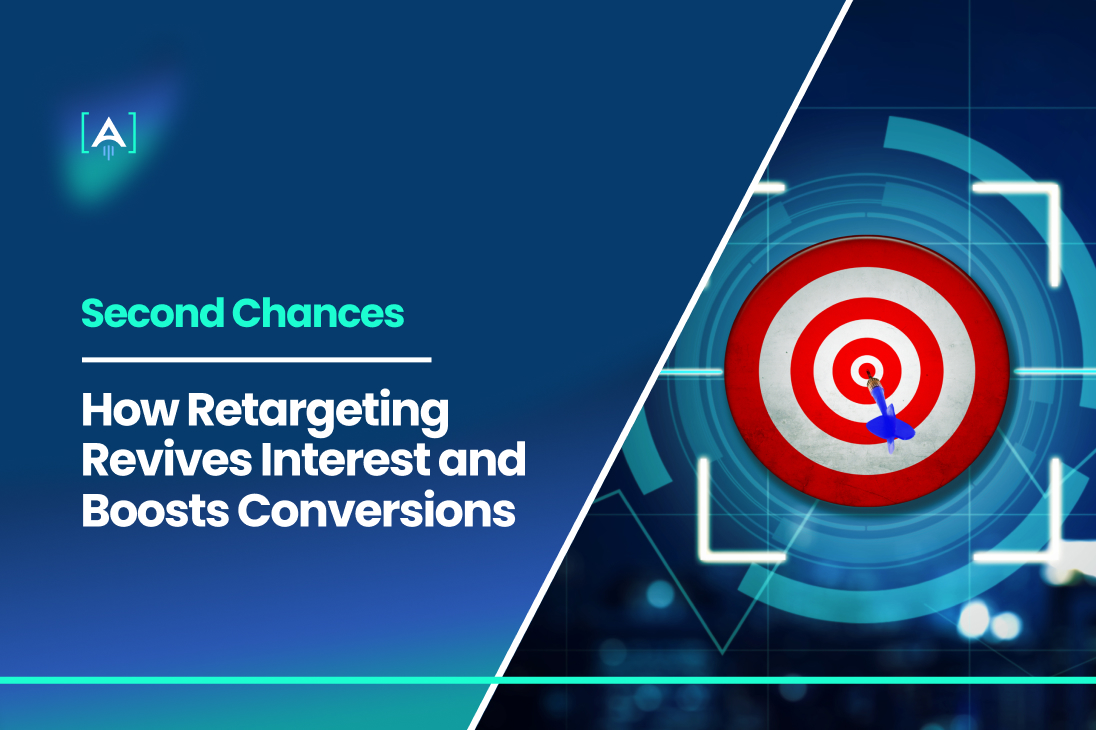Grabbing the attention of potential customers and making them come back is a challenge in digital marketing.
Did you know that getting a new customer might cost up to 25 times more than retaining an existing one? This is where retargeting steps in.
What is retargeting in digital marketing?
It is a powerful tool offering a second chance to reignite interest and guide users along the customer journey.
Retargeting in Digital Marketing

What is retargeting in digital marketing, and why is it gaining prominence?
Retargeting is pivotal in the customer journey, as it reignites the spark with users who have previously engaged with your brand.
It’s the art of offering second chances, reminding your audience of what they might have missed, and guiding them toward conversion funnel.
In this blog post, we’ll explore how retargeting turns second chances into success stories, transforming brief interest into enduring customer loyalty.
Understanding Retargeting

Retargeting shows ads to people who’ve interacted with your website or app but didn’t take the desired action.
Retargeting relies on browser cookies. When visiting your site, a cookie is dropped. If they leave without converting, these cookies trigger ads on other sites they visit.
Types of Retargeting
Now that you know the answer to “what is retargeting in digital marketing?” let’s dive into the two main types of retargeting: pixel-based and list-based.
This dynamic duo works behind the scenes to bring potential customers back to your website.
Pixel-Based Retargeting
When someone visits your site, a tiny pixel – a snippet of code – is placed on their device. This pixel quietly watches their online activities.
Later, as they surf other sites, this pixel signals the retargeting system, triggering ads related to what they checked on your platform.
List-Based Retargeting
List-based retargeting is like having a VIP list at your startup event.
Let’s say your startup organizes a virtual product launch.
Attendees who provided their emails but didn’t sign up for a trial can still be engaged.
With list-based retargeting, they might encounter ads showcasing the exclusive features they missed during the event, prompting them to sign up.
The Psychology Behind Retargeting: Why It Works
Understanding the psychology behind retargeting is like decoding the secret language of customer behavior. It’s about tapping into human curiosity and decision-making.
Retargeting works based on some factors:
- Familiarity Breeds Trust: Imagine you’re at an event, and you meet someone for the first time. The more you see that person, the more familiar and trustworthy they become. Retargeting works on a similar principle. The more users encounter your brand across various sites, the more they trust and recognize it. This familiarity plays a crucial role in reducing customer churn. It keeps your brand top of mind and reinforces trust over time.
- The Power of Reminders: In digital marketing, distractions are aplenty. Users might visit your site, get distracted, and forget to take the desired action. Here’s where you need to create retargeting ads. It’s a gentle reminder, nudging them to revisit.
- Tailored Experiences Matter: Personalization is the key to customer hearts. Retargeting thrives on offering tailored experiences. If users explore your company’s finance solutions, retargeting ensures they see ads emphasizing those features, creating a seamless and personalized journey.
- Timing is Everything: Retargeting capitalizes on this by showing ads at strategic moments. A founder researching marketing tools might see an ad for your startup’s solution when narrowing down options, increasing the likelihood of conversion.
Setting Up Retargeting Campaigns

Setting a retargeting campaign demands meticulous planning and strategic execution.
Let’s explore it step by step:
- Choose the Right Platform: Where do your potential clients spend their digital time: Google, Facebook, LinkedIn, or other platforms? If your business targets B2B clients, LinkedIn might be the optimal stage for your retargeting ads.
- Implement Tracking Codes and Pixels: These small snippets of code are your digital breadcrumbs. Implement them on your website or app to track user behavior.
- Segment Your Audience: Group your audience based on their interactions – those who visited specific pages, abandoned carts, or engaged with certain content. Tailor your retargeting ads to each segment, delivering a more personalized and effective message. Retargeting campaigns also leverage the hook model to engage and convert prospects effectively.
Crafting Compelling Retargeting Messages

Crafting compelling retargeting messages is the foundation for a meaningful digital dialogue with potential clients.
Now, let’s explore how to strategically deploy these messages at different stages of the business funnel.
Personalization Techniques in Retargeting Ads
Personalization makes your messages stand out in the crowded digital space. Greet your audience by name and showcase products or services they previously explored.
For instance, if a founder showed interest in your business’s marketing solutions, a personalized ad could address them by name and highlight the tools they explored.
Creating Engaging and Relevant Ad Content
Keep the ad copy concise and compelling. Use visuals that resonate with your brand and the user’s previous interactions.
If a potential client visited your business’s software page, your retargeting ad could feature a quick video highlighting its user interface and functionalities.
Balancing Frequency and Timing to Avoid Ad Fatigue
Ad frequency is like a delicate dance – too much, and you risk stepping on toes. Space out your retargeting ads intelligently.
If a user recently visited your business site, wait before bombarding them with ads.
Retargeting Strategies for Different Stages of the Funnels

How can you deploy retargeting strategies at various stages of the business funnel?
Let’s see:
Top-of-Funnel Retargeting for Brand Awareness
The top of the business funnel is the grand entrance to your brand.
Retargeting takes center stage in this phase by consistently putting your brand in the spotlight.
If a potential client visited your homepage, a retargeting ad could vividly showcase your brand story, leaving a lasting first impression.
Mid-Funnel Retargeting for Engagement and Consideration
The middle of the funnel is an opportunity to deepen the customer connection.
Retargeting at this stage aims for engagement. Feature content that demonstrates the value of your products or services.
Bottom-of-Funnel Retargeting for Conversion
At the bottom of the funnel, the spotlight is on conversion. Craft retargeting messages that prompt action. Showcase limited-time offers, discounts, or free trials.
For instance, if a potential client checked out your subscription plans, a retargeting ad could emphasize a time-limited deal, encouraging them to take the final leap.
Integrating Retargeting with Overall Marketing Strategy

If you want to turn your customers’ actions into conversions, you’ve got to blend retargeting into your marketing.
Let’s break it down and see why it’s a game-changer for your business.
Aligning Retargeting with Email Marketing, Content Strategy, and SEO
Aligning retargeting with data-driven marketing, email marketing, content strategy, and SEO empowers you to reach your target audience through multiple channels.
Leverage retargeting to engage those who’ve visited your website or interacted with your brand, while email marketing nurtures leads, enticing them back to your site.
Content strategy and SEO work together to draw in new visitors and enhance your visibility in search results.
To streamline this integration:
- Maintain consistent messaging across all channels for a consistent brand experience.
- Personalize your retargeting and email campaigns using customer data, tailoring messages to their specific interests.
- Fuel your content strategy with valuable, informative content to attract and captivate new website visitors.
- Optimize your website for search engines, elevating its rank in search results. A study by Wordstream found that retargeted search ads lead to higher conversion rates than display ads.
Cross-Channel Retargeting Approaches
Cross-channel and multichannel retargeting seem alike, but they’re not.
Multichannel retargeting is hitting platforms like Facebook and LinkedIn but not linking them.
Cross-channel retargeting connects these channels, tracks what users do, and makes the customer journey smoother.
There are several different cross-channel retargeting approaches that you can use, including:
- Website Retargeting: Place little trackers (cookies) on your website visitors’ browsers. These trackers then help show them ads for your stuff on other websites, social media, and mobile apps.
- Email Retargeting: Send targeted emails to users who left their shopping carts hanging, opened your emails before, or checked out specific pages on your website. These emails might have personalized suggestions, discounts, or other cool stuff to get them to finish their purchases.
- Search Retargeting: Display ads to people who’ve searched for keywords related to what you’re selling. These ads appear in search results and other websites in the same advertising network.
- Social Media Retargeting: Show ads to people who’ve given your Facebook page a thumbs up, followed you on Twitter, or interacted with your posts on other social media. These ads can get specific based on age, interests, and what they’ve done before.
- Mobile App Retargeting: If people have downloaded your app, show them ads within it and on other mobile apps in the same advertising club.
Measuring and Optimizing Retargeting Campaigns

You may wonder if your retargeting efforts are hitting the bullseye. Let’s dive into the metrics.
Key Metrics to Track in Retargeting
What’s the scoop on tracking retargeting success? Keep your eyes on these metrics.
Click-through rate (CTR) is your navigation system, showing how many are taking the detour back to your site.
Conversion Rate is your destination marker, revealing how many make a move.
Return on Investment (ROI) is the treasure map, guiding you to where your marketing gold lies.
Analyzing and Interpreting Retargeting Data
Retargeting data is used to track the effectiveness of your retargeting campaigns.
Here are some questions you can answer with retargeting data:
- How many people saw my ads?
- How many people clicked on my ads?
- How many people converted from clicking on my ads?
- What is my retargeting ads’ average cost per click (CPC)?
- What is the average conversion rate of my retargeting ads?
- What channels are performing best for my retargeting campaigns?
Once you have a good understanding of what your retargeting data is telling you, you can use it to improve the performance of your campaigns. For example, you can:
- Adjust your bids: If you get fewer clicks than you would like, you may need to bid more for your ads. If your CPC is too high, you may need to bid less.
- Optimize your ad creative: If your ads are not converting well, you may need to change the headline, copy, or images.
- Target your ads more carefully: If you are not reaching the right people, you may need to narrow your targeting criteria.
- A/B test different channels: If you are not getting the desired results from one channel, you may need to try another.
Best Practices and Ethical Considerations in Retargeting

Businesses must follow regulations concerning user privacy – the GDPR and CCPA.
These regulations give individuals the right to control their data.
Businesses need to be transparent about how they collect and use user data. They need to give users the option to opt out of retargeting, and they need to delete user data once it is no longer needed.
Maintaining User Trust and Transparency
In addition to complying with privacy laws, businesses also need to make sure they are transparent with their users about how they use retargeting.
This means being upfront about how they use cookies and allowing users to control their cookie settings.
Examples of Effective Retargeting Campaigns

You need to use the right retargeting strategy to reach your target audience. Here are some brilliant examples of retargeting:
Bitdefender effectively uses retargeting ads by incorporating a special discount. The ad communicates that it’s a New Year’s discount, highlighting a substantial 56% off.
The “Buy Now” call-to-action creates a sense of urgency, suggesting a limited-time opportunity and encouraging immediate action to avoid missing out on the deal.
One of the successful Facebook retargeting campaigns by HubSpot shows your retargeting ads don’t have to result in an immediate purchase to be successful.
In this Facebook retargeting ad campaign, HubSpot displays relevant lead magnets to recent visitors who didn’t convert during their initial visit.
They aimed to guide visitors to the next phase of their sales journey.
Future Trends in Retargeting

What’s next in retargeting? Let’s explore the upcoming trends that could reshape the retargeting game.
AI and Machine Learning in Enhancing Retargeting
Artificial intelligence (AI) and machine learning (ML) are increasingly pivotal in shaping the landscape of retargeting.
These technologies can help in different ways:
- Making Predictions: Thanks to AI in marketing, we can guess what customers might do: buy something or leave a product behind. This helps us aim our retargeting efforts where they will most likely pay off.
- Dynamic Creative Optimization (DCO): AI can optimize ad creatives in real-time, tailoring messaging and imagery to match individual customer characteristics and interests.
- Knowing Each Customer: Thanks to AI, we can build detailed profiles for each customer – digging into their online history, knowing their age, and even understanding what they’re into.
Cross-Device Retargeting
Consumers use multiple devices, such as smartphones, tablets, and laptops, to browse online. Cross-device retargeting ensures that ads follow customers across these devices.
- Device Fingerprinting: Device fingerprinting techniques, which combine browser and device characteristics, allow advertisers to track users across devices without relying on cookies.
- Data Fusion: Combining data from different devices and data sources enables a more comprehensive view of customer behavior and preferences, guiding more effective cross-device retargeting campaigns.
- Cross-Device Attribution: Measuring the effectiveness of cross-device retargeting campaigns remains a challenge, but emerging attribution models are providing more accurate insights.
Advanced-Data Management Platforms (DMPs)
DMPs are central hubs for aggregating, organizing, and analyzing customer data from various sources.
Advanced DMPs offer sophisticated segmentation and targeting capabilities, enabling advertisers to reach the right customers with the right messages.
- Real-Time Data Ingestion: Advanced DMPs can ingest and process data in real-time, enabling immediate action and responsiveness in retargeting campaigns.
- Unified Customer Identities: DMPs can create unified customer identities by linking data from different sources, providing a holistic view of each customer.
- Behavioral Data Enrichments: DMPs can enrich customer data with external behavioral data, such as website visits, social media interactions, and purchase history.
AI Tools for Retargeting
AI retargeting tools and platforms help businesses reach the right people with the right ads at the right time.
Here are some AI tools to help you set up a retargeting campaign:
Criteo: Criteo is a popular retargeting platform that uses AI to deliver personalized ads based on user behavior. It has a global reach of over 1.9 billion active users and is known for its effectiveness in driving conversions.
Adobe Audience Manager: Adobe Audience Manager is a data management platform (DMP) that can be used for retargeting.
IBM Watson: IBM Watson is a cognitive computing platform that can be used for retargeting. It analyzes data to identify patterns and insights that inform more targeted ad campaigns.
Salesforce Einstein: Salesforce Einstein is an AI platform that can be used for retargeting. It offers a variety of features, including predictive analytics, dynamic creative optimization, and cross-device retargeting.
Appier: Appier is an AI-powered marketing platform that offers a variety of retargeting solutions, including dynamic creative optimization, cross-device retargeting, and programmatic retargeting.
Persado: Persado is an AI-powered copywriting platform that can be used to create more effective retargeting ad copy. Using AI, it analyzes customer data and identifies the most persuasive language to use in ads.
Neuro-Insight: Neuro-Insight is a neuroscience company that uses AI to measure the emotional impact of advertising. It can serve retargeting ads to generate a positive emotional response in customers.
Kenshoo: Kenshoo is an AI-powered marketing automation platform that can manage retargeting campaigns across multiple channels. It offers campaign optimization, reporting, and attribution.
Empowering Success: The Retargeting Revolution in Digital Marketing

Retargeting is your digital marketing sidekick. From sparking interest to sealing the deal, retargeting ensures you use the most of your marketing budget.
If you’re not sure where to start, a growth marketing agency can help you.
It’s time to embrace the magic of retargeting and turn missed opportunities into conversions.
As we peek into the future of AI and emerging tech, let retargeting be your guide in this dynamic digital journey.

